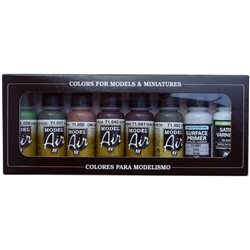Diorama derives from the greek dia (which means through) and horama (which means view).Diorama is one of those...
No products
Product successfully added to your shopping cart
There are 0 items in your cart. There is 1 item in your cart.
Search Tips
Why did warships wear dazzle camouflage patterns?
Dazzle Camouflage patterns were first introduced during the First World war in order to protect warships and merchant vessels from attack by U-Boats.
Initially, ships had been painted various shades of grey to camouflage them against the sea but the effectiveness of this process was disputed. It was then proposed that by painting ships with elaborate geometrical patterns their outlines could be sufficiently broken up. This would make it difficult to determine a vessel's course, angle and speed for a U-boat Captain viewing a target through a periscope. This gave rise to the saying 'don't hide them - confuse them', effectively vessels camouflaged into themselves.
Therefore a dazzle camouflaged vessel relied not on its ability to hide from a potential hunter but on its ability to confound them. There has been some debate as to how effective this process was and its use was continued into the Second World War. However, there was a very significant disadvantage in this theory as the US Navy found out to its cost in the Pacific.
Although a vessel wearing dazzle camouflage might be able to confuse a submarine captain or a torpedo bomber pilot at low level it was visible at enormous distances to Kamikaze pilots who tended to fly a lot higher and could thus see their targets earlier. This inevitably led to its abandonment and warships and merchant vessels reverted to more traditional low-visibility, fading orientated camouflage patterns.
Click here to receive the tips weekly in your mailbox. You can unsubscribe at any time.










